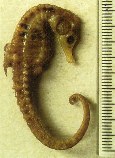http://www.fishbase.org/Summary/speciesSummary.php?genusname=Hippocampus&speciesname=capensis ---> http://192.134.151.83/Summary/speciesSummary.php?genusname=Hippocampus&speciesname=capensis
http://192.134.151.83/Summary/speciesSummary.php?genusname=Hippocampus&speciesname=capensis ---> https://fishbase.mnhn.fr/Summary/speciesSummary.php?genusname=Hippocampus&speciesname=capensis
https://fishbase.mnhn.fr/Summary/speciesSummary.php?genusname=Hippocampus&speciesname=capensis ---> https://fishbase.mnhn.fr/summary/Hippocampus-capensis.html
Hippocampus capensis, Knysna seahorse : aquarium

You can
sponsor
this page
Common name (e.g. trout)
Genus + Species (e.g. Gadus morhua)
-

-
About this page
-
Languages
-
User feedbacks
-
Citation
-
Uploads
-
Related species
-


 Knysna seahorse
Upload your
photos
and
videos
Knysna seahorse
Upload your
photos
and
videos
Pictures
|
Google image
 Hippocampus capensis
Hippocampus capensis
Female picture by
Lourie, S.A.
Teleostei (teleosts) >
Syngnathiformes
(Pipefishes and seahorses) >
Syngnathidae
(Pipefishes and seahorses) > Syngnathinae
Etymology:
Hippocampus:
Greek, ippos = horse + Greek,kampe = curvature (Ref.
45335
)
.
More on author:
Boulenger
.
Environment: milieu / climate zone / depth range / distribution range
Ecology
Brackish; demersal; non-migratory; depth range 0 - 27 m (Ref.
130565
). Temperate; 18°C - 22°C (Ref.
130565
); 33°S - 34°S
Southeast Atlantic: endemic to South Africa.
Hippocampus capensis
has the smallest known range of any seahorse and was the first to be assessed as threatened on the IUCN Red List, in 1994.
Length at first maturity / Size / Weight / Age
Maturity: L
m
5.8
range ? - ? cm
Max length : 12.1 cm OT male/unsexed; (Ref.
31848
); common length : 7.0 cm TL male/unsexed; (Ref.
4281
)
Short description
Morphology
|
Morphometrics
Dorsal
spines
(total): 0;
Dorsal
soft rays
(total): 16-18;
Anal
spines
: 0;
Anal
soft rays
: 3.
Found in bays and estuaries among submerged vegetation; diurnal (Ref.
4281
,
30915
). Can tolerate salinities from 1-59 ppt (Ref.
30915
). Ovoviviparous (Ref.
205
). The male carries the eggs in a brood pouch which is found under the tail (Ref.
205
). Length type refers to Height (= from top of coronet to the tip of straightened tail). Breeding in the aquarium is possible (Ref.
130565
).
Male carries the eggs in a brood pouch (Ref.
205
).
Lourie, S.A., R.A. Pollom and S.J. Foster
, 2016. A global revision of the seahorses
Hippocampus
Rafinesque 1810 (Actinopterygii: Syngnathiformes): taxonomy and biogeography with recommendations for further research. Zootaxa 4146(1):1-66. (Ref.
115213
)
IUCN Red List Status (Ref.
130435
)
Endangered (EN)
(B1ab(iii,v)+2ab(iii,v)); Date assessed:
09 March 2017
CITES
Appendix II:
International trade monitored
Not Evaluated
Threat to humans
Harmless
Human uses
Aquarium: commercial
FAO - Publication:
search
|
FishSource
|
More information
Countries
FAO areas
Ecosystems
Occurrences
Introductions
Stocks
Ecology
Diet
Food items
Food consumption
Ration
Common names
Synonyms
Metabolism
Predators
Ecotoxicology
Reproduction
Maturity
Spawning
Spawning aggregation
Fecundity
Eggs
Egg development
Age/Size
Growth
Length-weight
Length-length
Length-frequencies
Morphometrics
Morphology
Larvae
Larval dynamics
Recruitment
Abundance
BRUVS
References
Aquaculture
Aquaculture profile
Strains
Genetics
Electrophoreses
Heritability
Diseases
Processing
Nutrients
Mass conversion
Collaborators
Pictures
Stamps, Coins Misc.
Sounds
Ciguatera
Speed
Swim. type
Gill area
Otoliths
Brains
Vision
Tools
E-book
|
Field guide
|
Length-frequency wizard
|
Life-history tool
|
Point map
|
Classification Tree
|
Catch-MSY
|
Special reports
Check for Aquarium maintenance
|
Check for Species Fact Sheets
|
Check for Aquaculture Fact Sheets
Download XML
Summary page
|
Point data
|
Common names
|
Photos
Internet sources
AFORO (otoliths) |
Aquatic Commons
|
BHL
|
Cloffa
|
BOLDSystems
|
Websites from users
|
Check FishWatcher
|
CISTI
|
Catalog of Fishes
:
genus
,
species
|
DiscoverLife
|
ECOTOX
| FAO - Publication:
search
|
Faunafri
| Fishipedia |
Fishtrace
| GenBank:
genome
,
nucleotide
| GloBI |
Google Books
|
Google Scholar
|
Google
| IGFA World Record |
MitoFish
|
Otolith Atlas of Taiwan Fishes
|
Public aquariums
|
PubMed
| Reef Life Survey | Socotra Atlas |
Tree of Life
| Wikipedia:
Go
,
Search
| World Records Freshwater Fishing |
Zoobank
|
Zoological Record
Estimates based on models
Phylogenetic diversity index (Ref.
82804
): PD
50
= 0.5000 [Uniqueness, from 0.5 = low to 2.0 = high].
Bayesian length-weight: a=0.00447 (0.00177 - 0.01127), b=3.00 (2.78 - 3.22), in cm total length, based on LWR estimates for this (Sub)family-body shape (Ref.
93245
).
Trophic level (Ref.
69278
): 3.4 ±0.5 se; based on size and trophs of closest relatives
Resilience (Ref.
120179
): Low, minimum population doubling time 4.5 - 14 years (tm=1; Fec=7).
Fishing Vulnerability (Ref.
59153
): Low vulnerability (10 of 100).
Back to Search
Random Species
Back to Top
Accessed through:
Not available
FishBase mirror site :
localhost
Page last modified by :
mrius-barile
- 20 July 2016
Fatal error
: Uncaught ArgumentCountError: Too few arguments to function checkEcotox(), 1 passed in /var/www/html/summary/speciessummary.php on line 2304 and exactly 3 expected in /var/www/html/includes/speciessummary.lib.php:2579 Stack trace: #0 /var/www/html/summary/speciessummary.php(2304): checkEcotox() #1 {main} thrown in
/var/www/html/includes/speciessummary.lib.php
on line
2579
|